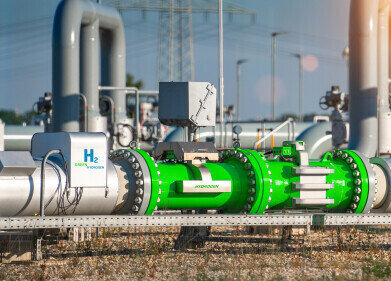Biofuel industry news
What pollutants are released by biofuel and biogas?
Jan 05 2024
In the final text of the agreement at COP28, the Parties commit themselves to ‘Tripling renewable energy capacity globally [...] by 2030’ as well as ‘Transitioning away from fossil fuels in energy systems’; hence the agreement was widely hailed as the first global commitment to ending fossil fuels.
When most people hear ‘renewable energy’, I’ll bet that their association is either a wind turbine or a solar panel, maybe even a hydroelectric dam or geothermal plant as deeper cuts. It may, then, come as a surprise to many readers that it is the opinion of the preeminent authority on climate science, the Intergovernmental Panel on Climate Change (IPCC), that bioenergy is a form of renewable energy – and many, many countries seem to be betting on it. Last year, the Global Biofuels Alliance was announced at the G20 summit, with participation from 19 countries, including Brazil, India, the United States and the United Arab Emirates, backed by global financial institutions, like the World Bank and the Asian Development Bank. With just 7 years to fulfil COP28’s commitment to tripling renewables, it seems like bioenergy will play a significant role in the energy mix of the near-future.
So, what are we getting ourselves into? Being renewable does not necessarily mean a form of energy is sustainable, nor does it mean that it has no effect on ecosystems. Whilst bioenergy has tremendous potential as both a renewable, sustainable and green form of energy, getting there’s going to be quite the tightrope walk.
Greenhouse gases
There is a fundamental similarity between bioenergy and fossil energy by virtue of their respective feedstocks. Although radically transformed by many millions of years of compression and heat, oil, coal and natural gas are still just forms of organic matter. As a result, combusting a biofuel or biogas will release some carbon dioxide, nitrogen oxide and methane. Unlike natural gas, refining biogas into biomethane has the potential to prevent the emission of both methane and nitrogen oxide whilst providing greater energy-density as well as more convenience since biomethane can be combusted and transported without specialist technology. Both methane and nitrogen oxide have significantly higher global warming potentials (GWPs) than carbon dioxide but methane’s 12-year lifespan in the atmosphere is considerably less then carbon dioxide’s 300+ years, whereas nitrogen oxide’s GWP is 300 times greater than that of CO2 and it sticks around for about 110 years. Any solution, then, which minimises the emission of nitrogen oxide ought to be welcomed – and biomethane is one such solution.
Yet, despite all of these climate-threatening similarities with fossil fuels, the IPCC contend that when produced correctly, bioenergy is ‘able to deliver 80 to 90% emission reductions compared to the fossil fuel energy baseline’ - but how? Whilst the difference in emissions between fossil- and bioenergy at the tailpipe remains unclear, it is argued that the absorption of CO2 during the growing of the crops used as feedstock renders bioenergy de facto carbon neutral. But such promise will be hard to achieve. Take, for instance, the fact that the most viable biofuels use food crops like maize (corn) or palm oil as their feedstock, rapidly ramping up the production of such fuels will put the squeeze on agricultural land and rising average temperatures will only tighten this bottleneck. In such circumstances, we’re flirting with rising food prices and incentivising deforestation that undermining the carbon neutrality of biofuels. One possible way around all of this is lignocellulosic biofuel, which takes agricultural residues or waste as feedstocks, allowing farmers to supplement their income by selling on their organic rubbish rather than re-orienting their business strategy around biofuels as opposed to food. Indeed, the IPCC’s figure of ‘80 to 90% emission reductions’ from bioenergy is partly premised upon ‘the use of biomass residues and waste’, wary as such institutions are of bioenergy’s fragile carbon-neutrality. However, viable solutions for the use of such feedstocks have not yet been developed.
In 2016, a paper published in Climatic Change found that the world’s largest producer of biofuel, the United States managed to “offset” or “re-absorb” just 37% of the CO2 emitted during the combustion of its ethanol and biodiesel products between 2005 and 2013. In other words, it may be the case that one of the few large-scale experiments in bioenergy has actually contributed to global warming. In Brazil, the world’s second largest biofuel manufacturer and home of the world’s most important carbon sink, the Amazon rainforest, things may be an order of magnitude more precarious. Whilst the current administration under President Luiz Inácio Lula da Silva is committed to protecting the Amazon, the previous incumbent, Jair Bolsonaro, was far more willing to sacrifice portions of “the Earth’s lungs” on the altar of Brazil’s bioenergy dominance, raising the perennial prospect of further wrecking the carbon-neutrality of biofuel (as well as accelerating climate change as a whole) every time the country’s political winds change directions.
Particulate matter
As with fossil fuels, incomplete or inefficient combustion of bioenergy can produce particulate matter. Those who work on air quality know that the most consequential species of air pollution for public health is particulate matter (PM) at 2.5 micrometers (PM2.5) in length, as these particles are small enough to enter the bloodstream through the lungs. One common type of PM2.5 is black carbon, a by-product of incompletely combusted hydrocarbons like fossil fuels or organic matter (and their derivatives, like biofuels or -gases). It’s one of a small group of air pollutants that function as both warming agents and toxins. As the Clean Air Fund put it earlier this month in a report that called on COP28 to devote more investment to cleaning it up, black carbon ‘sits uniquely at the centre of climate and health crises.’ For instance, a literature review compiled by the World Health Organisation in 2012 found ‘sufficient evidence of associations of all-cause and cardiopulmonary mortality with long-term average BC [black carbon] exposure.’ That same year, a paper published in Environmental Health Perspectives used established formulas to model the climate and health impacts of existing methods of reducing black carbon concentrations, finding that reducing average concentrations by just 23-34% could avoid anywhere from 600,000 to 4.4mn annual premature deaths worldwide by 2030. At the same time, it’s been well established that black carbon has a positive radiative forcing, meaning it increases the wattage of solar energy absorbed relative to that re-emitted. In short, it contributes to warming – but only in the short-term! Whereas CO2 sticks around for more than 300 years and methane stays in the atmosphere for around 12, black carbon is gone in weeks and days.
Now, to some degree, the rate of release of black carbon is a matter of technology. Most of the black carbon released by biofuel combustion comes from cooking or heating in under-developed regions, rather than the transport sector with its more effective engines. Abundant in such regions, non-refined or traditional bioenergy, like wood, dung or crop residues, are typically burned in open fires or traditional stoves, further endangering the already vulnerable. Unlike many of the other pollutants included here, then, particulate matter is not such an intractable problem; surmounting this class of pollutants is eminently achievable through up-scaling availability of efficient combustion technology and refined biofuels.
Volatile organic compounds (VOCs)
Another category of by-products formed during the combustion of biofuel are volatile organic compounds (VOCs). In fact, around 90% of the VOCs in the atmosphere are biogenic (i.e. non-anthropogenic), being frequently released by plants as these carbon-based chemicals evaporate at relatively low temperatures. So, it shouldn’t be surprising that when you ferment and combust these plants, they’ll release a few of these compounds, many of which threaten public health. As with black carbon, this release occurs when combustion is incomplete or inefficient – hence, most of the VOCs released by biofuel combustion come from cooking or heating in under-developed regions, rather than the transport sector with its more effective engines.
When it comes to bioenergy, there’s a spectrum running from edible vegetable matter (corn, sugarcane, flour, etc.) to lignocellulose (wood, stems, leaves, grasses, etc.) to animal fats – and wherever your fuel falls, it’s probably emitting aromatic compounds. Whether you’re burning wood pellets, animal fats, recycled cooking oil, there’s the possibility that you’ll release some aromatics and the further possibility of degrading public health. Such compounds have toxic, mutagenic and carcinogenic properties paired with high lipid-solubility. The only exception is alcohol-based biofuel, like ethanol fuel. Instead, you’re likely to produce some aldehydes during combustion, which poses its own risks. Low exposure to aldehydes raises the prospect of organ injury, inflammation and acute pain, whilst frequent and sustained exposure could promote cancers or cardiovascular disease.
NOx and SOx
Last but not least, there’s the problem of sulphur oxides and nitrogen oxides. Being the two most essential nutrients for soil, sulphur and nitrogen are present in many of the feedstocks used for bioenergy. When combusted, nitrogen and sulphur bond with oxygen, producing a range of compounds that can have deeply harmful impacts on the environment and public health. For instance, nitrogen dioxide is a nasty air pollutant with a range of respiratory impacts, like increasing the incidence of asthma and bronchitis. In combination with any type of nitrogen oxide, sulphur dioxide plays a critical role in the formation of acid rain, itself injurious to the respiratory system whilst malnourishing soil as well as driving harmful heavy metals into drinking water through the corrosion of pipes and drains.
In light of recent developments, securing a prominent role for bioenergy in the energy mix appears to be a foregone conclusion – and this means a whole host of challenges, many of them reminiscent of fossil fuels. Ensuring the efficiency of combustion, forging ahead with technologies for waste-based bioenergy and up-scaling the refinement of biogas into biomethane, each offer of the chance to minimize emission of harmful chemicals and secure the carbon-neutrality of bioenergy. On the possibilities of positive future for bioenergy, one recent development provides food for thought: the United Arab Emirates acquiring a 30% stake in Brazil’s second largest ethanol firm, Atvos. As the manufacturer’s website states, it is ‘one of the main issuers of Decarbonization Credits (CBIOs) in the country’ and it wouldn’t be surprising if this was precisely the purpose of Abu Dhabi’s investment. On the one hand, such investments increase the chance that new technological solutions will be developed to mitigate the dangers of bioenergy. But on the other, if the development of bioenergy is simply an excuse to burn more oil, it’s unlikely this inherently precarious alternative will ever live up to its promise. So, with all sorts of thresholds and targets looming in the middle-distance, bioenergy will no doubt continue to play its complex, ambivalent role in this critical decade.
Digital Edition
PIN 26.1 Feb/Mar 2025
March 2025
Analytical Instrumentation - Elemental Analysis for Quality and Process Control at Refineries, for Lubricants and Wear Metals in Engine Oils - Synthetic Lubricants: New Developments - Scaling...
View all digital editions
Events
Mar 17 2025 Houston, TX, USA
Mar 18 2025 Beijing, China
Mar 19 2025 Manila, Philippines
Mar 20 2025 Brussels, Belgium
Mar 20 2025 Guangzhou, China









.jpg)

.jpg)







